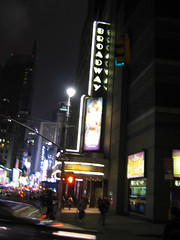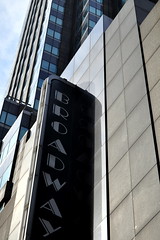South:Corner (888 8th Ave): Seasons, A Floral Design Studio; Sansha NYC Dance Store 260: This was the address of the Marshall Club, a gathering place in the early 1900s for black writers, musicians and performers. Novelist and songwriter James Weldon Johnson lived on the second floor. 242: ARO, a 54-story building designed by CetraRuddy, put up in 2018. It replaced the Roseland Ballroom, whose back entrance used to be here. (See 52nd Street.) ARO is, awkwardly, the first two letters of "Roseland" with the first letter of the name of Albert Ginsberg, who used to own it. Letters from the Roseland sign spell out "ARO" in the lobby. Broadway Theatre
Corner (1685 Broadway): Built in 1924 to a Eugene DeRosa design,
it was originally the Colony Theatre,
where "Steamboat Willie," the first talking
cartoon, debuted in 1928. (Mickey Mouse had been introduced in
"Plane Crazy" six months earlier.) After being
renamed the Broadway, it saw the premiere of
Fantasia in 1939.
|
W
|
North:Ed Sullivan Theatre(1697 Broadway): Built in 1927 as Hammerstein's Theater, Arthur Hammerstein's tribute to his father Oscar. It was later known as the Manhattan Theater and Billy Rose's Music Hall. In 1936, CBS began radio broadcasts from here, and
it was converted to a TV studio in 1950. It was home to
the classic show The Honeymooners as well as
The Merv Griffin Show, and such game shows as
What's My Line?, To Tell the Truth,
Password and The $20,000 Pyramid.
But it was most famously home to the The Ed Sullivan Show, which aired from here until its 1971 cancellation. It was here that Elvis Presley performed on September 9, 1956, the camera famously avoiding his swiveling hips, and The Beatles made their US television debut on February 9, 1964. After David Letterman moved to CBS in 1993, it was the studio for his Late Show, and his successor Stephen Colbert. The Mayor's Office of Film, Theatre & Broadcasting is located in this building and is accessed through the 53rd Street side. In the same building, at 1695 Broadway, is Omido, a sleek sushi restaurant designed by AvroKO. |

